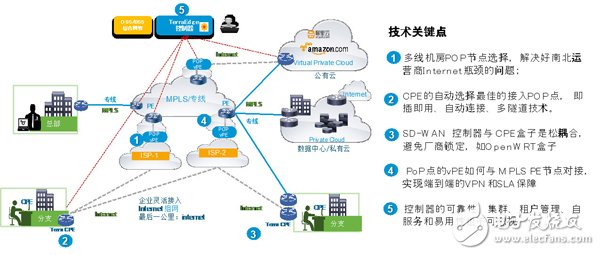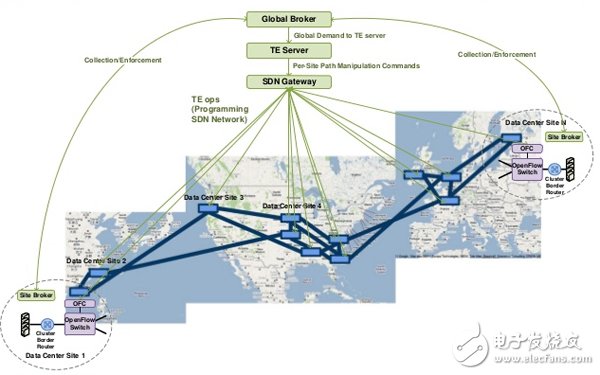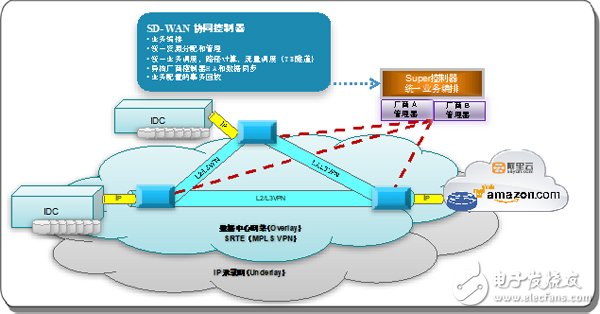Two days ago and colleagues of the company talked to the technical community of the Internet community, everyone unintentionally talked to the earliest proposer of BGP4 Tony Li, (a Cisco senior), proposed BGP4 agreement more than 20 years ago in the Internet, cloud data center today VXLAN EVPN, or backbone networks based on MPLS and SegemntRouTIng, are still in use and inheritance. Another magical person is Prof. Nick McKeown, one of the earliest proponents of SDN architecture and OpenFlow. Now he is turning to the leading programmable language P4 and founding. Barefoot Networks, Professor Nick is famed for his technological innovation and commercialization. Today, regardless of the latest Internet technologies, the hottest cloud network convergence and SDN networks, the thoughts and concepts of these two legends are still inherited.

With emotion, the launch of a series of SD-WAN deployment cases on the market in early 2018 brought SD-WAN to a new upsurge once again. When it comes to SD-WAN, there are many good articles on the Internet recently, especially for many SD-WAN technical principles and developments. History, features, and so on, but from the perspective of SD-WAN specific practice deployment, the article is not too many. As an old network engineer, he has undergone several major transformations of WAN technology and recently participated in several large-scale SDN-based WANs. Build and set up a project. On the occasion of the tenth anniversary of the development of SDN technology, we will share some experiences from the perspective of SD-WAN deployment and share it with everyone.
This article will share three different scenarios of SD-WAN deployments, including: SD-WAN access - Internet Edge-based solution, SD-WAN backbone - Core solution based on SRTE traffic scheduling, and multi-vendor WAN-based SDN collaborative controller or business collaboration arranger. These three scenarios are more representative and are the typical SD-WAN requirements encountered. The following figure is based on the schematic diagram of the architecture of the Earth Cloud Network. It is easy for everyone to understand!

The first type of deployment scenario:
SD-WAN access service is also the most typical and popular scenario. Sometimes called SD-WAN Edge solution, operators can use this technology as an alternative to MPLS or next-generation MPLS. Enterprises can use this technology to implement branch offices. On-demand networking.
On behalf of the customer case: In March 2018, Nanling Technology announced that it has become the first domestic WAN solution provider capable of providing customers with a wide range of applications including MPLS VPN, IPSEC VPN, and SD-WAN across the country.
Market Demand Situation: With the increasing demand for on-demand access to enterprises' cloud and WAN, the traditional MSTP and MPLS dedicated line services are difficult to meet the needs of the cloud and Internet era because of cost and long deployment period, and are oriented towards the Internet and The SD-WAN of the POP path selection technology is born. This is an SDN-WAN deployment scenario for branch flexible access. Due to the large-scale deployment of domestic carriers' MPLS VPN networks, operators will not replace MPLS or other private line services with SD-WAN in the short term, but will use SD-WAN technology to enrich MPLS VPN services or serve as the last-mile access. technology.

The main technical implementation: In fact, SD-WAN has no essential innovation in technology, but SD-WAN has made new breakthroughs in concept, integrated SDN control idea with POP line SLA detection technology, and can achieve cloud network integration Collaborative deployment, technical implementation as shown in the figure: SD-WAN general technology and general functions are not described here. In the previous two days, an article was written in great detail. Here we will talk about several considerations from the perspective of actual deployment:
In the SD-WAN design and deployment, the issue of the Internet bottleneck between North and South operators needs to be considered in China. When the customer deploys the design, it will choose to deploy multi-line POP nodes in multiple equipment rooms and deploy vPE equipment at each POP node. The vPE establishes a backbone network to protect the traffic SLA of the SD-WAN aggregation. In this case, the vPE of the POP node is formed through the customer's MPLS PE node (in other projects, we use SRTE as the backbone traffic scheduling). In a large SD-WAN deployment, each CPE detects and selects the best POP node based on the controller's distribution list and connects the best provider's vPE. Both the Edge and the Core are required for the SD-WAN design. Consider the SLA protection of the line, and then use the SDN controller to deploy unified routing, security, and QOS policy deployment and control of the entire network, so as to solve the problems of Internet-based access service quality and unified network-wide deployment.
Another problem to be solved is how the tenants of the SD-WAN interface with existing MPLS tenants (tenant branches may be SD-WAN lines, and some are MPLS dedicated hybrid networks). The aforementioned major carriers are basically the same. All of them have their own MPLS network. The interconnection between SD-WAN and MPLS VPN must be considered. There are multiple scenarios for how we can automate the connection between the PoP point vPE and the MPLS PE node, including the managed PE and OpTIon B. Overlay and so on;
The backup and load sharing between the automatic deployment of CPE and traditional routing devices, including lines, is also a key factor for the success of SD-WAN. Because most manufacturers' SD-WAN controllers are tightly coupled with CPE boxes, the latter is caused The vendor locks in, so there are several suggestions to consider: Does the CPE box support OpenWRT? How is the small box ZT-PnP automatic deployment mechanism (firewall traversal capability)? How does the CPE automatically select the access point with the least delay or the best bandwidth? Whether plug-and-play, automatic connection, and automatic switching can be done.
For the core of the entire system is the SDN controller, controller reliability, clustering, tenant self-service management, and ease of use are not to be ignored. As an operator, SD-WAN controllers are usually required for northbound and existing BSS/ OSS docking integration is also considered. Although SD-WAN does not have large innovative technologies, a complete and mature SD-WAN solution is not technically simple. It is obvious that SD-WAN deployment and maintenance are easy to use, and companies no longer need professional CCIE. Personnel design and operation and maintenance, the traditional MPLS deployment may take several months for the extension and deployment of branches, and it is theoretically possible in minutes.
The second type of deployment scenario:
SD-WAN Core Backbone Scheduling (including DCI) for service providers and large enterprises. Typical scenario: SD-WAN backbone scheduling (including DCI) for large carriers and OTT customers, and SD-WAN core backbone network for large enterprises. On behalf of the customer case: Google B4 commercial deployment SD-WAN classic case project (released in 2012) and February 2018 Industrial and Commercial Bank of China released SDN backbone deployment based on MPLS.

The main market demand: The core idea of ​​SD-WAN backbone scheduling is traffic scheduling and multi-tenant based service and management. Sometimes we also call it the SD-WAN DCI/Core solution. This solution and the aforementioned Internet-based The SD-WAN Edge is very different in function and positioning, but the two solutions are complementary.
There are mainly three main ways to implement the major technologies:
The first type based on the white card + Openflow SDN controller - Google B4 is based on this program (2010-2012), the core of Google B4 is its TE scheduling and algorithm and it cleverly avoided the many defects of Openflow, including DSCP is used as the forwarding policy of the flow table based on the source and destination addresses, but the key technical details of the project (such as the SDN controller platform algorithm) are not publicly announced or sold externally. Latecomers may mimic but rarely exceed it. In addition to Google, I said that I understand that some customers have feedback on this combination of solutions, including the ability of the White Label to support SRTE, the performance and number of BFD/Tunnel support, routing policies and VPN capabilities, the size of the switch flow table and the port cache, etc. And so on, after all, the solution of the switch can't be overwhelmed. Not to mention that Nick McKeown is now turning to the leading programmable language P4 and creating Barefoot Networks. Of course, there is a new idea in the industry based on the White Plan's Overlay solution, using vPE with white. The board solves the above-mentioned problems. The vPE is complementary to the switch to implement traffic scheduling and routing policies. Due to space problem here is not in discussion;
The second type is based on MPLS + SDN controller to achieve the entire network traffic scheduling and VPN tenant management - similar to the ICBC SD-WAN backbone network (2017 release), MPLS TE has been deployed for many years, the current deployment of the customer's customer to see Most of the complaints about the deployment of MPLS TE are too complex and therefore not really used in the TE tunnel of the production network. Because the MPLS is mature enough, there is no shortage of advanced technologies.
The third type of solution is also what the author would like to see. It is based on SR (Segment RouTIng) to achieve traffic scheduling and management of SR+SDN controllers, similar to the MPLS network, but SR negotiable based on the source to form a complete LSP Path and The existing MPLS network is compatible, because SR is also based on label switching. It is only necessary to simply expand the existing IGP protocol to implement functions such as TE, FRR, and MPLS VPN, including automatic TE for traffic engineering. Delivery, automatic calculation, automatic adjustment, automatic drainage and automatic scheduling.

The SRTE-based SDN controller is currently a very advanced technology in the industry. The basic forwarding table of the SR is even simpler than the LDP. The source routing technology and the SDN concept are used in a perfect combination. In terms of traffic TE management, the SRTE is less than the RSVP-TE state. Many, do not need to be as complicated as LDP/RSVP signalling. However, current hardware vendors (including third-party controllers + SR routers) still have a certain gap in the SRTE implementation. However, there are several points that need to be considered when deploying:
How to dynamically adjust the TE path in real time according to the link quality (load/loss/delay) to implement global load balancing
Tunnel fast switching strategies and escape algorithms (such as Cisco PBTS technology),
Configure rollback consistency, offline traffic planning,
Symmetrical fault detection of the TE path.
The features of various programs vary greatly. It is very rare that SDN controllers based on SRTE can be completely implemented in China. As a domestic company focused on SDN's overall architecture and software technology platform, after experiencing more than two years of technological breakthroughs and R&D tests, the company has successfully overcome this daunting technical challenge and has for the first time implemented a complete SR-TE commercial controller. Platform and begin commercial deployment.
The third type of deployment scenario:
Based on multi-vendor SDN collaboration controllers or business collaboration orchestrator, large-scale operators, OTT customers, and mega-companies have begun to consider in the SD-WAN multi-vendor heterogeneous environment.
On behalf of the customer case: China Unicom announced in March 2018 that "China's first large-scale operator, cloud-network convergence commercial SDN, was successfully launched (SD-WAN DCI system based on China Unicom's A-net)". Major market demand: in the front two broad categories of SD- When a WAN is deployed, customers often need a balance between devices from multiple vendors. Customers do not want to be locked by vendors. However, at present, most SD-WAN networks are closed management systems. They are based on multi-vendor SDN collaboration controllers or service collaboration. The organizer is a difficult problem. The problem of unified management of interoperability and resources requires upper-layer SDN collaboration controllers to solve the problems. This type of solution is especially important for the operation of large-scale SDN networks. At present, several major operators and OTT industries have realized or started to consider this issue. It is believed that in the future, enterprise customers will have similar requirements along with SDN deployment.
Main technical realizations: Taking an operator as an example, two years ago, we started to research the collaborative work of multi-vendor controllers in an MPLS backbone network under the cloud environment, and after two years of design, development, testing, and joint debugging, the difficulties of each link In an effort, the customer became the first operator in China to implement cloud network integration services on the backbone of the country. At the same time, it also created a large-scale SDN project in China, and selected independent core SDN software companies to cooperate with a number of large-scale network equipment manufacturers to ensure that operators can fully control and control SDN operation requirements and technical architecture and decision-making discourse. This provides a successful case for the commercial integration of on-time cloud network integration products.
However, multi-vendor co-controllers need to be custom-developed according to the customer's actual business conditions. SDN software vendors need to have strong R&D capabilities and industry experience, including in-depth knowledge of vendor-hardware northbound interface specifications and cloud network technologies (such as VXLAN The integration of EVPN, L2/L3 MPLS, SR TE, Neutron, Docker CNI, ODL, etc., mainstream public cloud systems, and integration with customer OSS/BSS business systems are actually very complex and not common SDN vendors. Played with the company. As shown in the figure, with more SD-WAN scenarios and more multi-vendor deployments, multi-vendor collaborative management and unified orchestration will become an important topic for SD-WAN in the future.

Finally, look forward to the future of SD-WAN
SD-WAN is a new idea and architecture innovation under the background of high-speed internet development and cloud network convergence. SD-WAN's breakthrough in concept is far greater than innovation in technology. For the sake of time and space, we share with you this time. The three types of SD-WAN related cases and deployment scenarios seem to look like three separate SD-WAN solutions on the surface, but in terms of architecture, it is a complete three-dimensional architecture.
Today's SD-WAN journey has already begun. The value and significance of SD-WAN as a new business model is immeasurable. We believe that future SDN can better understand applications and serve applications (Intent-Based SDN and Traffic Intelligence Analysis) provides precise intelligent scheduling capabilities (especially in SRTE and POP detection and selection algorithms) and can provide more powerful intelligent operation and maintenance tools to escort Underlay and Overlay, in addition to the future openness and common standards of SDN. Interoperability (not locked by vendors) is also a goal that we have been pursuing. We will not forget our early intentions. Let us wait and see.
Medical Defibrillator Wire Harness
Medical defibrillator Wire Harness is a very successful case of our factory, and it is also a more representative customized wiring harness. A defibrillator is a medical device that uses a strong pulse current to pass through the heart to eliminate arrhythmia and restore sinus rhythm. Defibrillation is one of the most important steps in performing CPR.
For the engineering department of Kable-X R&D and innovative design fro wiring harness, it is responsible for the company's engineering technology and engineering research and development, and analyzes the new customer samples (drawings/custom samples) provided by the business at the first time, so as to improve the company's interests. Put first, supervise and manage the cost, and do a good job of cooperating with other departments.
We produce a large number of Medical Cable Assembly, including Ventilator Wire Harness, Medical Defibrillator Wire Harness and Medical Aid Equipment Wire Harness.

Medical Defibrillator Wire Harness,UL Cable For Medical Equipment,Medical Cable Harness,Medical Defibrillator Wire Harness For Sale
Kable-X Technology (Suzhou) Co., Ltd , https://www.kable-x-tech.com